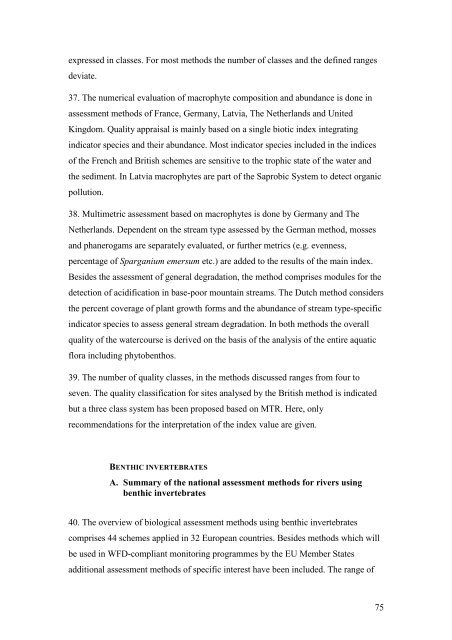Report on Harmonisation of freshwater biological methods
Report on Harmonisation of freshwater biological methods
Report on Harmonisation of freshwater biological methods
You also want an ePaper? Increase the reach of your titles
YUMPU automatically turns print PDFs into web optimized ePapers that Google loves.
expressed in classes. For most <strong>methods</strong> the number <strong>of</strong> classes and the defined rangesdeviate.37. The numerical evaluati<strong>on</strong> <strong>of</strong> macrophyte compositi<strong>on</strong> and abundance is d<strong>on</strong>e inassessment <strong>methods</strong> <strong>of</strong> France, Germany, Latvia, The Netherlands and UnitedKingdom. Quality appraisal is mainly based <strong>on</strong> a single biotic index integratingindicator species and their abundance. Most indicator species included in the indices<strong>of</strong> the French and British schemes are sensitive to the trophic state <strong>of</strong> the water andthe sediment. In Latvia macrophytes are part <strong>of</strong> the Saprobic System to detect organicpolluti<strong>on</strong>.38. Multimetric assessment based <strong>on</strong> macrophytes is d<strong>on</strong>e by Germany and TheNetherlands. Dependent <strong>on</strong> the stream type assessed by the German method, mossesand phanerogams are separately evaluated, or further metrics (e.g. evenness,percentage <strong>of</strong> Sparganium emersum etc.) are added to the results <strong>of</strong> the main index.Besides the assessment <strong>of</strong> general degradati<strong>on</strong>, the method comprises modules for thedetecti<strong>on</strong> <strong>of</strong> acidificati<strong>on</strong> in base-poor mountain streams. The Dutch method c<strong>on</strong>sidersthe percent coverage <strong>of</strong> plant growth forms and the abundance <strong>of</strong> stream type-specificindicator species to assess general stream degradati<strong>on</strong>. In both <strong>methods</strong> the overallquality <strong>of</strong> the watercourse is derived <strong>on</strong> the basis <strong>of</strong> the analysis <strong>of</strong> the entire aquaticflora including phytobenthos.39. The number <strong>of</strong> quality classes, in the <strong>methods</strong> discussed ranges from four toseven. The quality classificati<strong>on</strong> for sites analysed by the British method is indicatedbut a three class system has been proposed based <strong>on</strong> MTR. Here, <strong>on</strong>lyrecommendati<strong>on</strong>s for the interpretati<strong>on</strong> <strong>of</strong> the index value are given.BENTHIC INVERTEBRATESA. Summary <strong>of</strong> the nati<strong>on</strong>al assessment <strong>methods</strong> for rivers usingbenthic invertebrates40. The overview <strong>of</strong> <strong>biological</strong> assessment <strong>methods</strong> using benthic invertebratescomprises 44 schemes applied in 32 European countries. Besides <strong>methods</strong> which willbe used in WFD-compliant m<strong>on</strong>itoring programmes by the EU Member Statesadditi<strong>on</strong>al assessment <strong>methods</strong> <strong>of</strong> specific interest have been included. The range <strong>of</strong>75














![Accommodation booking form [PDF]](https://img.yumpu.com/39471785/1/184x260/accommodation-booking-form-pdf.jpg?quality=85)

